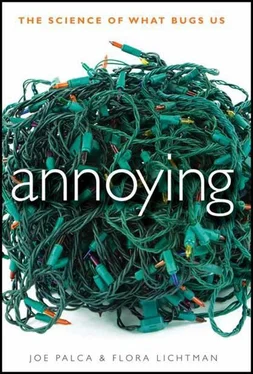To demonstrate how powerful this effect is, Simons and his colleague Christopher Chabris made a video of six people passing two basketballs among themselves. You may have seen it—a rare academic study that went viral on the Internet. In the video, three of the people are wearing white shirts; the others are wearing black shirts. The white-shirted players pass only to other white-shirted players, and the black-shirted players do likewise. As they pass the balls among themselves, they dance around one another, so keeping track of who’s passing to whom requires attention. It’s like trying to keep track of which walnut shell the pea is under, if you’re familiar with that game.
In Simons’s experiment, he told subjects to watch the video and count how many times the players in white shirts passed the ball to one another. The video starts in a straightforward manner, with the players weaving and passing, weaving and passing. After about twenty seconds, however, a woman in a gorilla suit walks into the frame from the right, pauses, faces the camera, thumps her chest, and walks out of the frame to the left. All the while, the players continue to weave and pass.
At the end of the fifty-second video, Simons asks subjects whether they saw the gorilla. Typically, 50 percent of the people ask, “What gorilla?” Only after showing them the video a second time, this time with no instruction to count the number of passes, do subjects see the gorilla. Then everyone sees it. It’s completely obvious. No one can believe that the gorilla was “invisible” the first time around. Why do some people miss it? And what does this have to do with coping with annoyance?
Basically, people don’t see the gorilla because “there is no conscious perception without attention,” as Simons puts it. “What’s more, the level of inattentional blindness depends on the difficulty of the primary task.”
Sports psychologist Benjamin Conmy would have applied a version of Simons’s concept of inattentional blindness to Chamberlain’s circumstances in the Bug Game. Conmy advises players that there should be “a total immersion in only the aspects of the present that are germane to accomplishing the task. So, for Chamberlain, that’s executing a baseball pitch. You want athletes to be so immersed in what they are doing that they almost forget where they are. They’re so dialed in that they don’t think about anything else.” When the insects appeared on the field, however, they interfered with Chamberlain’s consciousness. “Now he’s aware of where he is, how he is doing, how these insects might be affecting his preparation,” says Conmy. To get Chamberlain back on track, “I would have had him walk away from the situation and get centered again. Because there was nothing he could do about the situation. The bug spray wasn’t working. The umpires clearly weren’t going to give him a respite. I would have had him say to himself, The next three or four pitches may not be perfect, but they don’t have to be disastrous.”
The point is that as irritating as the bugs were, they didn’t suddenly make Chamberlain an inept pitcher. He was still a fantastic player. “And that’s what he needed to focus on,” says Conmy. “He needed to realize that he was still completely in control of how well he was pitching this year. The insects were something he couldn’t control, and he should have just dealt with that and functioned to the best of his ability.”
It sounds easy, but try that the next time you miss your connecting flight. The fact that it’s something you can’t control is exactly why it drives you crazy. Yet it’s also true that if it’s all in your head, only you can do something about it.
Another approach that Conmy would have used in the circumstances is something he calls cognitive restructuring. “I would have said to him, ‘Remember, Joba, one of the hardest things to do in the world is to hit a baseball. These flies are clearly in this batter’s vision. They’re flying in and out of his eyes. He has no chance of hitting any of the pitches you can throw right now.’”
A final note on the Bug Game saga. It is not possible to speak for all entomologists, but it’s certain that many of them become annoyed when people confuse bugs and insects. The nonbiting midge Chironomus plumosus is not a bug. “All bugs are insects, but not all insects are bugs,” the Entomological Society of America Web site informs us. {25} 25 2. Entomological Society of America, “Frequently Asked Questions on Entomology,” http://www.entsoc.org/resources/faq#triv4 .
“True bugs are part of the order Heteroptera , which includes stink bugs, water striders, and bed bugs.” (Bed bugs, by the way, are practically the mascot for Team Annoying. They’re disgusting, they’re random in whom they afflict, and you can never be quite sure you’ve seen the last of them.) The nonbiting midge is part of the order Diptera , insects that include gnats, mosca, mosquitoes, and true flies.
Entomologist David Denlinger says that when he was a kid, it did annoy him when people used the term bug inappropriately. Now that he’s older, he accepts the fact that nonexperts use the words bug and insect interchangeably. “I’m cool with that.”
Unless the midge attack was orchestrated by the Cleveland Indians or their supporters, Joba Chamberlain’s woes can be considered an act of God, as they say in insurance policies, or an act of Nature, as Darwin put it in On the Origin of Species . {26} 26 3. Charles Darwin, On the Origin of Species (London: John Murray), 1859.
Just because something’s out of your control, though, doesn’t mean it’s outside of everyone’s control.
In sports and in life, there are times when the provocation is intentional, executed with the specific goal of putting you off your game. It’s the art of “trash talk.” Conmy says it’s one of the most common ways that athletes try to create a small advantage over their opponents at a level where any advantage could mean the difference between a win and a loss. Trash talk spans a wide spectrum, according to Conmy, but all flavors of trash talk have a common purpose: to distract and annoy.
At one end of the spectrum are players who simply try to divert the attention of their opponents. “Some of them, their entire aim is to just be very funny, very gregarious, very entertaining, and get the player opposite them to stop thinking about the skills that allow them to perform well in the game,” says Conmy. In the middle of the spectrum are people who don’t say anything intrinsically annoying, but whose constant prattle becomes annoying during the course of a match. Conmy knew a soccer player who continually discussed cheese with the player he was guarding, from the first minute on. “He’d say, ‘Do you like cheese? I like cheese. What kind of cheese do you like? I like cheddar.’ And on and on and on. Imagine that for ninety minutes! And then there are the trash talkers who try to insult the other player,” he says. “To take his natural aggressiveness and push him over the edge.”
Into that last category falls Marco Materazzi. His trash talking elicited a shocking explosion from one of the best soccer players in the world, an explosion witnessed live by television viewers around the world.
The scene was the finals of the 2006 World Cup: Italy versus France. Materazzi was a star for the Italians. His victim was Zinedine Zidane. Both France and Algeria claimed Zidane as a citizen, but the tall midfielder chose to play for the French national team. He’s one of only four players ever to score in two World Cup finals. Tough, tall, and creative, he was one of soccer’s superstars. In 1998, he led the French to victory over Brazil. In 2002, however, injuries prevented him from making much impact for his national team. That year, France exited the tournament in the first round without managing to score a single goal. In 2004, Zidane decided to retire from international soccer.
Читать дальше












